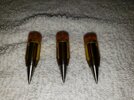I was thinking about these and realized I don’t know much about them. Are they even used anymore? I remember the old 30-30 Accelerator that uses a sabot to fire a 22 caliber bullet, but they aren’t made now, which indicates they probably didn’t work very well.
I also see them in shotguns and black powder rifles. Are they velocity limited so relegated to those slower applications?
I also see them in shotguns and black powder rifles. Are they velocity limited so relegated to those slower applications?


